You will need:
Socket wrench and 10mm socket
A good Flat-headed screwdriver
Coolant (Either Concentrate or 50/50 mix) ;
De-ionised water (Ideally, but you may get away with using tap water depending on where you live);
A suitable container to catch the old coolant (Needs to be big enough to hold all the old fluid, but small enough to fit under the car;
Disposable latex gloves (I'd recommend a number of pairs so you can change to a new pair once they get covered in coolant).
Funnel
Replacement Jubilee clips (Check condition first, you may not need these)
Important!!!
Wait until your engine is cold before starting this job, never remove the radiator filler cap whilst the engine is hot!
Do not allow coolant to come into contact with your skin, or with the painted surfaces of your car!
Never leave coolant lying around where it could be ingested by pets or children!
Do not pour coolant into the water drains. It is recommended that you take your old coolant to a recycling centre. Failing that, small quantities are permitted to be poured into foul drains (down the toilet), from what I've read online.
Everyone has their own technique for doing this, but this is my first coolant change and I just followed the Haynes manual.
Haynes has this down as a level 3 difficulty (fairly difficult) but it's fairly easy if you take your time.
First of all, remove the air filter box, this makes easier to get to the rear bleed screw.
Remove the radiator cap (Haynes recommend a wad of rag over the cover as you take it off, but if your engine is cold you shouldn't need one)
Undo the bleed screws
Front:
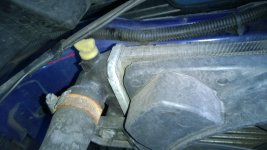
Rear:
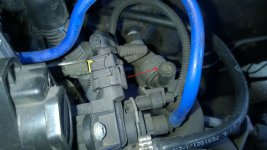
Place your container underneath the radiator bottom hose, undo the jubilee clip on the bottom hose
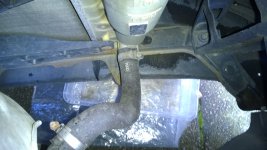
and then wiggle the hose from the radiator stub.
(Be ready, the coolant drains from the system very fast!)

Your gloves will now be completely covered in coolant, unless you're lucky, change for a fresh pair to avoid covering everything you touch with the stuff.
If coolant renewal has been neglected or the mixture has become diluted, it is recommended that you flush your system. The radiator should be flushed independently from the engine, to avoid contamination.
Undo the jubilee clip and remove the radiator top hose
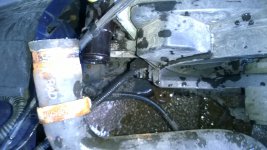
Insert a hosepipe into the top of the radiator and turn on the water.
Turn off as soon as clean water runs from the bottom of the radiator. It helps if you have someone ready to turn it off for you.
I didn't flush my engine as the rad was clean and I was rushing a bit, so no pics for this I'm afraid, but here are the steps anyway:
Remove the thermostat housing;
Insert a hose pipe into the bottom radiator hose (still disconnected from rad)
and turn on. Turn off once clean water runs from thermostat housing opening in the cylinder head;
Replace thermostat housing.
Now put the top and bottom hoses back on the radiator and replace jubilee clips if necessary. Make sure that the clips are on tight.
Pour your coolant into the expansion tank (see the label on your coolant for amount, in my case 1.5L) You may want to use a funnel.
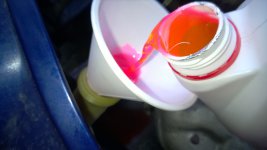
Top up with water (unless you're using 50/50 mix) until coolant emerges from the bleed screws. Close each bleed screw as it emerges. Squeeze the rad hose between adding water to remove any air from the system.
Continue to top up to the MAX mark, take your time so as not to overfill, and refit radiator cap.
Its a real pain to drop the level down to the MAX mark. (Or at least it was for me).
Ensure that bleed screws are fully closed.
Start engine and let it idle for 2 to 3 minutes. Allow the engine to run until the electric cooling fan operates, but during this time periodically increase the engine speed gradually to 2000 to 3000 rpm.
Stop the engine completely and allow it cool down completely.
Check for leaks, particularly around disturbed components.
Check the level in the expansion tank, and top up if neccessary.
Socket wrench and 10mm socket
A good Flat-headed screwdriver
Coolant (Either Concentrate or 50/50 mix) ;
De-ionised water (Ideally, but you may get away with using tap water depending on where you live);
A suitable container to catch the old coolant (Needs to be big enough to hold all the old fluid, but small enough to fit under the car;
Disposable latex gloves (I'd recommend a number of pairs so you can change to a new pair once they get covered in coolant).
Funnel
Replacement Jubilee clips (Check condition first, you may not need these)
Important!!!
Wait until your engine is cold before starting this job, never remove the radiator filler cap whilst the engine is hot!
Do not allow coolant to come into contact with your skin, or with the painted surfaces of your car!
Never leave coolant lying around where it could be ingested by pets or children!
Do not pour coolant into the water drains. It is recommended that you take your old coolant to a recycling centre. Failing that, small quantities are permitted to be poured into foul drains (down the toilet), from what I've read online.
Everyone has their own technique for doing this, but this is my first coolant change and I just followed the Haynes manual.
Haynes has this down as a level 3 difficulty (fairly difficult) but it's fairly easy if you take your time.
First of all, remove the air filter box, this makes easier to get to the rear bleed screw.
Remove the radiator cap (Haynes recommend a wad of rag over the cover as you take it off, but if your engine is cold you shouldn't need one)
Undo the bleed screws
Front:

Rear:

Place your container underneath the radiator bottom hose, undo the jubilee clip on the bottom hose

and then wiggle the hose from the radiator stub.
(Be ready, the coolant drains from the system very fast!)

Your gloves will now be completely covered in coolant, unless you're lucky, change for a fresh pair to avoid covering everything you touch with the stuff.
If coolant renewal has been neglected or the mixture has become diluted, it is recommended that you flush your system. The radiator should be flushed independently from the engine, to avoid contamination.
Undo the jubilee clip and remove the radiator top hose

Insert a hosepipe into the top of the radiator and turn on the water.
Turn off as soon as clean water runs from the bottom of the radiator. It helps if you have someone ready to turn it off for you.
I didn't flush my engine as the rad was clean and I was rushing a bit, so no pics for this I'm afraid, but here are the steps anyway:
Remove the thermostat housing;
Insert a hose pipe into the bottom radiator hose (still disconnected from rad)
and turn on. Turn off once clean water runs from thermostat housing opening in the cylinder head;
Replace thermostat housing.
Now put the top and bottom hoses back on the radiator and replace jubilee clips if necessary. Make sure that the clips are on tight.
Pour your coolant into the expansion tank (see the label on your coolant for amount, in my case 1.5L) You may want to use a funnel.

Top up with water (unless you're using 50/50 mix) until coolant emerges from the bleed screws. Close each bleed screw as it emerges. Squeeze the rad hose between adding water to remove any air from the system.
Continue to top up to the MAX mark, take your time so as not to overfill, and refit radiator cap.
Its a real pain to drop the level down to the MAX mark. (Or at least it was for me).
Ensure that bleed screws are fully closed.
Start engine and let it idle for 2 to 3 minutes. Allow the engine to run until the electric cooling fan operates, but during this time periodically increase the engine speed gradually to 2000 to 3000 rpm.
Stop the engine completely and allow it cool down completely.
Check for leaks, particularly around disturbed components.
Check the level in the expansion tank, and top up if neccessary.

